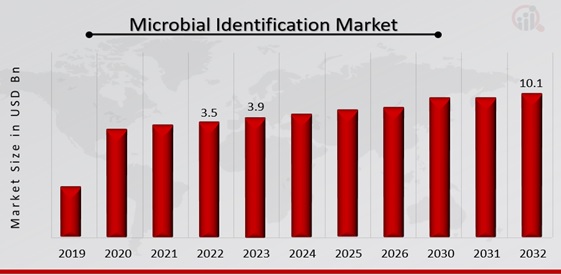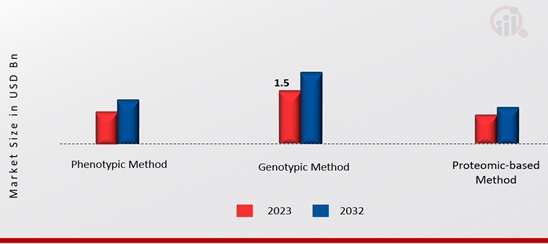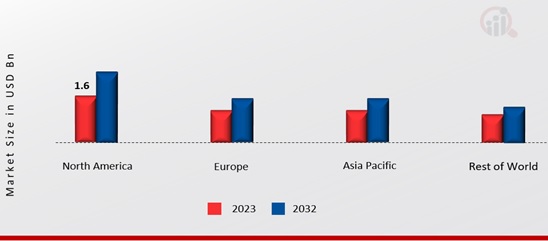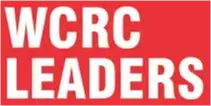Global Microbial Identification Market Overview
As per MRFR analysis, the Microbial Identification Market Size was estimated at 5 (USD Billion) in 2024. The Microbial Identification Market Industry is expected to grow from 5.63 (USD Billion) in 2025 to 16.37 (USD Billion) till 2034, at a CAGR (growth rate) is expected to be around 12.60% during the forecast period (2025 - 2034).

Source: Secondary Research, Primary Research, MRFR Database and Analyst Review
Microbial Identification Market Trends
- Rising demand for instruments is driving the market growth
Market CAGR for microbial identification is driven by several factors, including the rising prevalence of infectious diseases, increased public awareness of microbiological testing, and the emergence of technologically improved products. Over time, a larger variety of microorganism strains have been included in the distinct organism range. Among them are methods for quickly identifying isolated organisms in clinical specimens using mass spectrometry (MS).
The need to identify the microorganisms causing infectious diseases is growing as these diseases become more common. In Ghana's Ashanti region, two fatal instances of Marburg virus disease (MVD) were recorded; both cases subsequently proved positive for the Marburg virus, according to WHO data released in July 2022. According to the Global Tuberculosis Report 2022, 10.6 million individuals were predicted to have TB globally in 2021.
Additionally, increasing companies' activities in creating microbiological testing products over the projection period should support segment expansion. For example, Bruker Corporation announced new products and techniques for the MALDI Biotyper (MBT) platform, called MALDI Biotyper Sirius, in July 2021. This platform supports workflows for rapid, almost universal, and affordable microbial identification through a process known as "proteomic fingerprinting" using culture plates and positive blood cultures. Additionally, bioMérieux acquired the CE marking of VITEK MS PRIME in April 2021. This is the next generation of VITEK MS MALDI-TOF mass spectrometry systems, allowing routine microbial identification in minutes.
Moreover, Autobio Diagnostics Co., Ltd. presented their completely automated solutions for microbial identification and antibiotic susceptibility testing (ID-AST) at this year's ECCMID, the biggest international conference for infectious disease specialists and clinical microbiologists, in April 2022. Autobio showcased the AutoMic-I600 automated ID-AST system at ECCMID 2022. This system facilitates rapid and precise microbiological identification and ID-AST, enabling automated sample pipetting, incubation, and detection.
Additionally, because NGS provides entire genomic data, it may identify microorganisms with unprecedented accuracy and resolution, allowing for high-precision identification of pathogens at the strain and species levels. Accurately describing complex microbial ecosystems and identifying uncommon or novel diseases depend on this skill. By enabling high-throughput sequencing of several samples at once, NGS platforms greatly improve the productivity and throughput of procedures for microbial identification. This scalability is especially helpful for extensive epidemiological research, epidemic investigations, and surveillance systems, thus driving the Microbial Identification market revenue.
Microbial Identification Market Segment Insights
Microbial Identification Product & Service Insights
The Microbial Identification Market segmentation, based on Product & Service, includes instruments, consumables, [reagents & kits, and plates & media], and services. In 2023, the consumables segment dominated the market. Culture media, reagents, and test kits are consumables in the microbiological identification sector that must be regularly refilled. These consumables are continuously needed in laboratories and research institutes to conduct microbial identification tests. Manufacturers and suppliers profit steadily from this constant demand for replacements. For instance, Lovibond's test kits are designed for industrial use starting in August 2023. Owing to the growing significance of water resources and the legal requirements governing their responsible management, Lovibond seeks to provide comprehensive solutions that can successfully handle particular requirements and enable accurate, simple water analyses. It is projected that these releases will accelerate the segment's growth.
The services category is anticipated to be the fastest growing. Contract testing laboratories offer next-generation sequencing (NGS) analysis, molecular diagnostics, and culture-based assays for microbiological identification to pharmaceutical businesses, food producers, environmental authorities, and healthcare providers. The need for laboratory testing services is fueled by the necessity for outsourcing, capacity limitations, and the specific knowledge needed for microbiological analysis.
Microbial Identification Method Insights
Based on Methods, the Microbial Identification Market segment includes the phenotypic method, genotypic method, and proteomic-based method. In 2023, the genotypic method category generated the most income. High precision and specificity are provided by genotypic methods, which include DNA fingerprinting and sequencing. They can detect bacteria at the genetic level, which frequently yields more accurate findings than phenotypic techniques. Furthermore, various applications, such as environmental evaluations, epidemiological studies, clinical diagnostics, and microbial diversity research, employ genotypic approaches. The broad range of applications has aided the market segment's expansion.
The microbial identification phenotypic method segment is anticipated to grow fastest during the forecast period. Isolating microorganisms from dietary, environmental, or clinical specimen samples on selective or differential media is the process of culture-based approaches. Phenotypic traits such as colony morphology, growth patterns, hemolysis, and biochemical reactions are studied to identify microorganisms to the genus or species level.
Figure 1: Microbial Identification Market, by Method, 2023 & 2032 (USD Billion)

Source: Secondary Research, Primary Research, MRFR Database and Analyst Review
Microbial Identification Technology Insights
Based on Technology, the Microbial Identification Market segmentation includes mass spectrometry, PCR, microscopy, flow cytometry, and other technologies. The PCR category leads the market due to the high accuracy, speed, and adaptability of microbe detection and identification. Because PCR allows particular DNA sequences to be amplified, it is extremely sensitive and can find even minute amounts of microbial DNA. Furthermore, because of its capacity to swiftly and precisely detect pathogens, it is extensively employed in clinical diagnostics, research labs, and diverse sectors for microbiological identification, serving a crucial role in environmental monitoring, food safety, and disease diagnosis.
During the projection period, the microbial identification market’s mass spectrometry segment is anticipated to grow fastest. Because of its remarkable sensitivity and specificity, mass spectral fingerprinting (MS) technology makes it possible to identify and detect microorganisms down to the species and strain level. This feature makes it possible to precisely identify microorganisms, even in complex samples that comprise several species.
Microbial Identification Application Insights
The Microbial Identification Market segmentation, based on Application, includes diagnostic applications, pharmaceutical applications, environmental applications, food testing, beverage testing, cosmetics and personal care products testing, and other applications. The diagnostic applications category leads the market. The increasing occurrence of infectious diseases is expected to drive the segment's growth. Furthermore, it is anticipated that improvements in molecular biology methods, such as PCR and next-generation sequencing, would greatly boost the efficiency and precision of microbiological identification in medical contexts. It is projected that these developments and the increased incidence of infectious diseases would spur the expansion of clinical diagnostics markets to provide more effective and accessible.
The pharmaceutical applications segment of the microbial identification market is predicted to develop at the quickest rate over the projected period. The pharmaceutical sector directly influences the development of vaccines and therapies for newly emerging infectious diseases. The pharmaceutical industry has benefited greatly from accurate and quick microbial identification, which is crucial during epidemic outbreaks. Therefore, during the forecast period, the growing prevalence of infection disorders is expected to propel the segment's rise in the microbiological identification market.
Microbial Identification End User Insights
Based on End Users, the Microbial Identification Market segmentation includes hospitals, diagnostic laboratories and blood banks, food manufacturing companies, pharmaceutical companies & CROs, beverage manufacturing companies, and other end users. The hospitals diagnostic laboratories and blood banks category leads the market. Hospitals can improve patient outcomes and lower the risk of antibiotic resistance by using microbial identification to assist them in choosing the right antimicrobial therapy based on the susceptibility profile of infections. Moreover, diagnostic labs offer microbial identification services to inpatient and outpatient populations for various infectious disorders, such as bacterial, viral, fungal, and parasitic infections. Additionally, transfusion-transmitted infections (TTIs) can be avoided by screening given blood for infectious agents such as bacteria, viruses, and parasites using microbial identification.
The pharmaceutical companies and CROs category of the microbial identification market is expected to grow at the fastest rate over the estimated period. Pharmaceutical companies and CROs use microbial identification techniques to detect and describe microbial isolates from factory settings, machinery, and utilities to avoid product contamination and guarantee product quality.
Microbial Identification Regional Analysis
By region, the study provides market insights into North America, Europe, Asia-Pacific, and the Rest of the World. The North American Microbial Identification market will dominate this market due to several factors, including the rising prevalence of infectious diseases and epidemics, the presence of key companies, and new product introductions.
In November of 2022, the CDC released an update on the E. coli epidemic associated with frozen falafel, which included 20 recorded instances of sickness and five hospitalizations. The infectious disease connected to the dietary ingredients is verified via microbial identification. Furthermore, throughout the forecast period, the appearance of major market players in the area and the development of increasingly technologically sophisticated goods are anticipated to support market expansion. In January 2022, for instance, BD obtained FDA 510(k) clearance for its BD Kiestra IdentifA system, which is intended to automate the production of microbiological bacterial identification tests. Bruker Corporation introduced the MBT Sepsityper Kit US IVD in January 2021 to facilitate the quick identification of over 425 bacteria from positive blood cultures using the MALDI Biotyper CA System.
Further, the major countries studied in the market report are the US, Canada, Germany, France, the UK, Italy, Spain, China, Japan, India, Australia, South Korea, and Brazil.
Figure 2: MICROBIAL IDENTIFICATION MARKET SHARE BY REGION 2023 (USD Billion)

Source: Secondary Research, Primary Research, MRFR Database and Analyst Review
Europe's Microbial Identification market accounts for the second-largest market share. Europe has a well-established healthcare system, including clinical laboratories, hospitals, and research institutes with cutting-edge equipment and knowledge. With the help of this infrastructure, advanced microbial identification technologies can be adopted and integrated into regular clinical practice and research operations. Further, the German Microbial Identification market held the largest market share, and the UK Microbial Identification market was the fastest-growing market in the European region.
The Asia-Pacific Microbial Identification Market is expected to grow at the fastest CAGR from 2024 to 2032. Investments in biotechnology and pharmaceutical firms, as well as in healthcare and other industries, have increased due to the rising incidence of infectious diseases and the economic development of nations such as China and India. This has boosted the market for microbiological identification solutions and the segment's expansion. Moreover, China’s Microbial Identification market held the largest market share, and the Indian Microbial Identification market was the fastest-growing market in the Asia-Pacific region.
Microbial Identification Key Market Players & Competitive Insights
Leading industry participants are making significant R&D investments to broaden their product offerings, contributing to the further expansion of the Microbial Identification market. In addition, market players are engaging in various strategic endeavors to broaden their worldwide reach. Significant developments in the market include introducing new products, agreements under contracts, mergers and acquisitions, increased investment, and cooperation with other entities. It must provide affordable products for the Microbial Identification sector to grow and thrive in an increasingly competitive and rising market environment.
One of the main strategies manufacturers use in the worldwide Microbial Identification market to benefit customers and expand the market sector is local manufacturing to reduce operating expenses. Some of the biggest benefits to medicine in recent years have come from the Microbial Identification sector. Major players in the Microbial Identification market, including bioMérieux SA, Danaher Corporation, Merck KGaA, Becton, Dickinson and Company, Thermo Fisher Scientific Inc., Bruker Corporation, Avantor, Inc., Biolog, Inc., Shimadzu Corporation, and QIAGEN NV, and others, are attempting to increase market demand by investing in research and development operations.
Molecular testing solutions are offered by Qiagen NV (Qiagen). In addition to assay technologies to determine the genetic makeup of a pathogen in a tumor, bioinformatics solutions to analyze and interpret genomic data, and consumables automation solutions to streamline molecular testing workflows, the company offers sample technologies that aid in the isolation and processing of DNA, RNA, and proteins from samples such as blood, tissue, and other materials. Food safety testing, forensics, veterinary diagnostics, human healthcare, biotechnology, and life sciences research are among the industries it services. The company distributes its products directly and through a network of independent distributors. QIAGEN introduced a comprehensive Sample to Insight workflow in November 2023 designed for microbiome research. This workflow is expected to expedite research processes, encompassing DNA extraction kits, bioinformatics analysis, and whole genome metagenomics library creation.
Scientific instruments, as well as analytical and diagnostic products, are designed, produced, and distributed by Bruker Corp. (Bruker). Customers in the life science research, pharmaceutical, biotechnology, surface measurement, preclinical imaging, CBRNE detection, food, agricultural, applied markets, cell biology, clinical research, microbiology, in-vitro diagnostics, nanotechnology, and material science research sectors use products from Bruker. It provides technologies related to mass spectrometry, microtomography, magnetic resonance, gas and liquid chromatography, triple quadrupole mass spectrometry, atomic force microscopy, X-ray, spark-optical emission spectroscopy, stylus and optical metrology, fluorescence optical microscopy, and platforms for infrared and Raman molecular spectroscopy. Innovative mycobacteria and fungus IVD solutions for the Novel LiquidArray and MALDI Biotyper gastrointestinal syndromic panel were unveiled by Bruker Corporation in April 2023.
Key Companies in the Microbial Identification Market Include
Microbial Identification Industry Developments
April 2022: Bruker Corporation's exclusive LiquidArray technology enhances the novel multiplex PCR infectious disease assays it has developed. The FluoroType Mycobacteria PCR assay, introduced on the high-precision FluoroCycler XT thermocycler, allows the company to broaden its range of mycobacteria. It leverages potent LiquidArray technology to distinguish 31 clinically significant non-tuberculous mycobacteria and the M. tuberculosis complex from cultures in a single test.
March 2022: The Arc Module and BC Kit together form the Accelerate Arc system, which Accelerate Diagnostics, Inc. introduced as an automated method for microbial identification for positive blood cultures that is quick and precise. The system's design aims to reduce cross-reactivity and false positive results associated with quick multi-targeted molecular assays while eliminating the need for overnight culture incubation.
Microbial Identification Market Segmentation
Microbial Identification Product & Service Outlook
- Instruments
- Consumables
- Reagents & Kits
- Plates & Media
- Services
Microbial Identification Method Outlook
- Phenotypic Method
- Genotypic Method
- Proteomic-based Method
Microbial Identification Technology Outlook
- Mass Spectrometry
- PCR
- Microscopy
- Flow Cytometry
- Other Technologies
Microbial Identification Application Outlook
- Diagnostic Applications,
- Pharmaceutical Applications
- Environmental Applications
- Food Testing
- Beverage Testing
- Cosmetics and Personal Care Products Testing
- Other Applications
Microbial Identification End User Outlook
- Hospitals, Diagnostic Laboratories and Blood Banks
- Food Manufacturing Companies
- Pharmaceutical Companies & CROs
- Beverage Manufacturing Companies
- Other End Users
Microbial Identification Regional Outlook
- North America
- Europe
- Germany
- France
- UK
- Italy
- Spain
- Rest of Europe
- Asia-Pacific
- China
- Japan
- India
- Australia
- South Korea
- Australia
- Rest of Asia-Pacific
- Rest of the World
- Middle East
- Africa
- Latin America
| Report Attribute/Metric |
Details |
|
Market Size 2024
|
5.00 (USD Billion)
|
|
Market Size 2025
|
5.63 (USD Billion)
|
|
Market Size 2034
|
16.37 (USD Billion)
|
|
Compound Annual Growth Rate (CAGR)
|
12.60 % (2025 - 2034)
|
|
Report Coverage
|
Revenue Forecast, Competitive Landscape, Growth Factors, and Trends
|
|
Base Year
|
2024
|
|
Market Forecast Period
|
2025 - 2034
|
|
Historical Data
|
2020 - 2024
|
| Report Coverage |
Revenue Forecast, Market Competitive Landscape, Growth Factors, and Trends |
| Segments Covered |
Product & Service, Method, Technology, Application, End User, and Region |
| Geographies Covered |
North America, Europe, Asia-Pacific, and the Rest of the World |
| Countries Covered |
The US, Canada, Germany, France, UK, Italy, Spain, China, Japan, India, Australia, South Korea, and Brazil |
| Key Companies Profiled |
bioMérieux SA, Danaher Corporation, Merck KGaA, Becton, Dickinson and Company, Thermo Fisher Scientific Inc., Bruker Corporation, Avantor, Inc., Biolog, Inc., Shimadzu Corporation, and QIAGEN NV |
| Key Market Opportunities |
· Growing awareness about food safety procedures, personalized medicine, and precision agriculture |
| Key Market Dynamics |
· Increasing prevalence of infectious diseases and growing technological advancements |
Frequently Asked Questions (FAQ) :
The Microbial Identification Market size was valued at USD 3.9 Billion in 2023.
The global market is projected to grow at a CAGR of 12.60% during the forecast period, 2024-2032.
North America had the largest share of the global market
The key players in the market are bioMérieux SA, Danaher Corporation, Merck KGaA, Becton, Dickinson and Company, Thermo Fisher Scientific Inc., Bruker Corporation, Avantor, Inc., Biolog, Inc., Shimadzu Corporation, and QIAGEN NV.
The Consumables category dominated the market in 2023.
The Genotypic Method had the largest share in the global market.





























